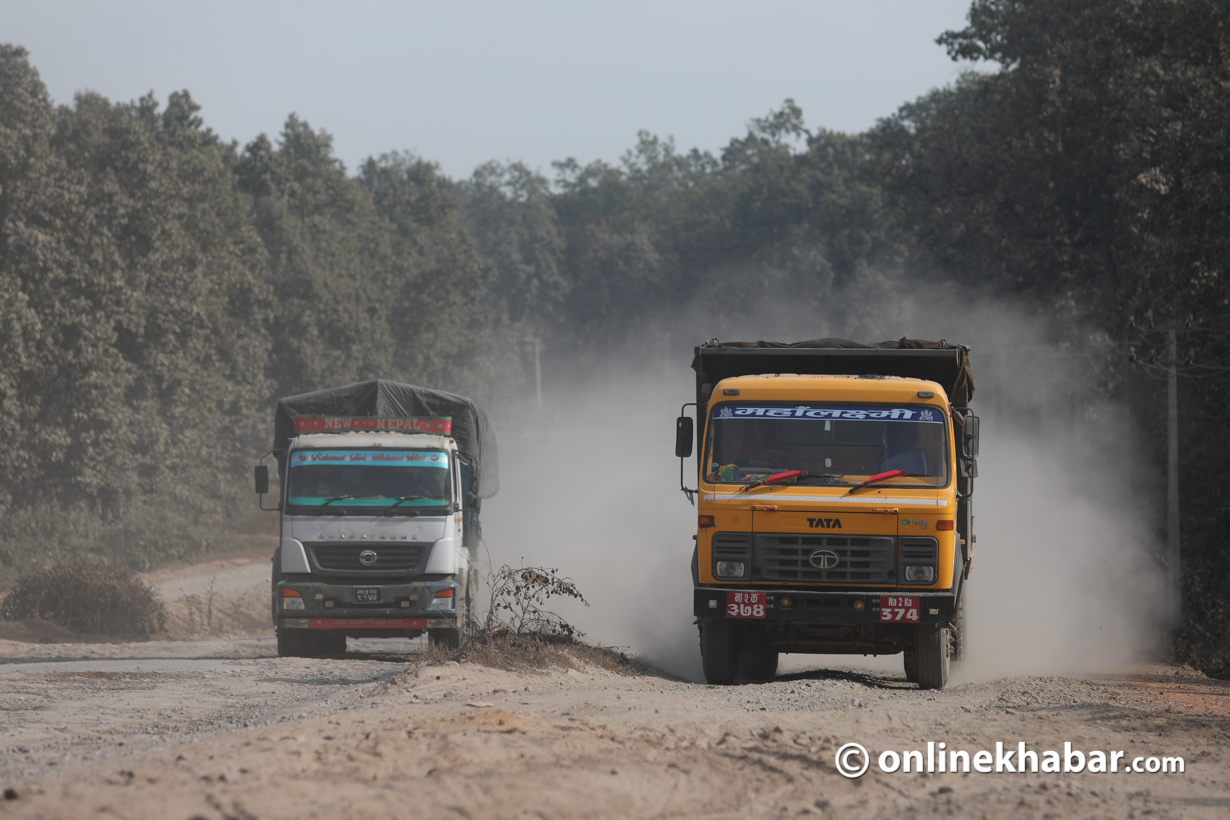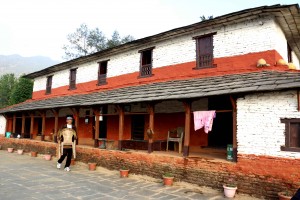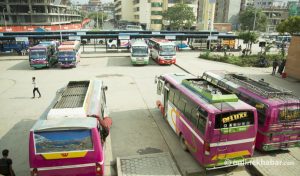
On December 22, 2023, a truck with the number RJ-02 GB 5204, carrying furniture materials from India to Kathmandu overturned while crossing the Daunne Danda in Nawalpur. Those aboard the truck were confused about what exactly happened.
The driver was navigating the road quite well but suddenly a puff of dust obscured his vision and before he knew it he lost control of the vehicle as it hit a large pothole and turned sideways.
It took nearly a day to transfer all the goods from one truck to another. Frustrated, the driver left Nepal lamenting how poor the roads are in the country.
“This is beyond a joke anymore. I want to take this chance to salute the drivers who have to drive on this road every day,” said the driver as he boarded a bus to leave Nepal.
The expansion of the Butwal-Narayangadh road section under the East-West Highway has been ongoing for the past five years. Since 2018, only 35 per cent of work has been completed. The road often sees more demolition than actual construction which has frustrated both commuters and transport entrepreneurs who say the haphazard and slow process has affected their business negatively.
The state of the Pokhara-Mugling is also similar as it is moving at a snail’s pace. On January 4, 32 passengers were injured when a passenger bus travelling from Birganj to Pokhara crashed at Myagdi Rural Municipality-6 Mauribazar in Tanahu. The bus overturned after losing control on the road under the expanding Prithvi Highway. Such incidents have become common on Nepal’s major highways.
Transport entrepreneurs woes

Saroj Sitaula, senior vice-president of the Federation of Nepalese National Transport Entrepreneurs (FNNTE), says that the Butwal-Narayangadh road has put the long-distance transport business on the brink. He says that the poor road conditions have affected almost all transport entrepreneurs who have spent millions.
“Highways are being built and expanded from east to west, but everything is done so slowly. This has meant many transport entrepreneurs have decided to quit the business,” he says.”The business which had been adversely affected by the Covid pandemic is on the brink of shutting down.”
He says that additional financial losses were incurred due to accidents as transport entrepreneurs had to allocate significant funds for passenger treatment. Furthermore, the poor road conditions have also meant longer travel times. That coupled with risk during travel has meant people have stopped travelling on roads and choose to fly instead.
“The road condition has affected people’s psychology. This has affected us a lot and things will not change any time soon,” he says.
According to Sitaula, the maintenance and operation costs of vehicles have also increased. Busses have been breaking down often which has posed additional challenges for transport entrepreneurs.
“Things are tough. We don’t know how many people have exited from the scene, but many have suffered and continue to do so due to the country’s poor state,” says Sitaula.
Damar Raj Pant, Chairperson of Mahakali Multi-Purpose Transport Pvt Ltd, says that the Butwal-Narayangadh road has been a headache for transport entrepreneurs for the last five years and the suffering is never-ending as it is uncertain how long it will take to complete the road development.
According to Pant, vehicles used to remain in good condition for eight to 10 years with timely servicing before the road expansion, but now this has become a myth.
“New vehicles get worn out within a year due to the condition of the road,” he says. “Why should one invest here, when the condition is pathetic?”
Pant says that buses with powerful engines, purchased at huge investments, are breaking down within three years. He says that the main reason for the deepening crisis in the transport business is the weak road infrastructure.
“The highway itself is like a wreck, and why should our business not be wrecked.”
Sluggish road development

The allegations made by transport entrepreneurs regarding the adverse effects of dust and potholes on the lifespan of vehicles appear valid when considering the condition of road sections undergoing expansion. In the case of the 113-kilometre Butwal-Narayangadh road section, vehicles are experiencing difficulties due to potholes. What was once a two-hour journey on this road now takes a minimum of four to six hours.
Construction on the 95-kilometre road section from Mugling to Nagadhunga is going at a snail’s pace. With construction materials piled up on the road, drivers feel a major accident is waiting to happen on the road.
“New busses are suffering the most. The potholes have also increased the risk of accidents. With one bus breaking down continuously, transport entrepreneurs have to pay a huge price,” says Pant.
Suresh Hamal, President of Trishiddeshwari Rapti Transport Services Pvt says transport entrepreneurs have stopped investing in the business because a bus now will make a loss rather than a profit.
“When the bus does not make money, it makes no sense to continue investing. This is why there are many buses on that go to western Nepal,” says Hamal.
According to Hamal, before the road expansion in Butwal began, the Trishiddeshwari Rapti Committee used to add 20 to 25 vehicles annually. However, due to the deteriorating condition of the highway, this number has dwindled to 8 to 10. Hamal says that with 20 transport entrepreneurs exiting the transport business, only eight new transport entrepreneurs have entered the industry.
“No matter how comfortable the vehicle is, the road will kill it quickly. When most of the money is going on maintenance and repairs, who will be brave to invest more money?” he questions.
While in the past adding a new bus to the fleet was a matter of prestige, it is now considered a major risk, says Hamal.
“The transport business suffers from unhealthy competition. Now with the roads adding more challenges, no one wants to spend a penny on developing the business,” he says.

Hamal further states that vehicles are purchased through high-interest loans, and in case of accidents on the highways, the owners bear the brunt. Additionally, the poor road conditions contribute to an increase in time constraints for drivers on long routes.
“We’ve started to lose drivers as well. Most seek employment abroad,” says Hamal.
Shiv Bhandari of Tulsipur, Dang, who is driving a passenger bus on the Dang-Kathmandu route, is also considering taking a break from driving. He’s been driving for over 40 years and feels it is time to do something new as he is sick of driving on the poor roads in Nepal.
“I cannot endure this any longer. I don’t think it is possible to make a living driving on these roads any longer,” he says.
He recalls how he made six trips between Dang and Kathmandu a month around 30 years ago. He says a bus back then used to run without major issues for nearly a decade.
“That is no longer the case. Everyone was happy and making good money. Now, things are not the same,” he says.
Bhandari says that as travel time increases, the cost of operating the vehicle also rises. According to him, a bus on this route typically required 240 litres of diesel, but now it consumes 320 litres.
“This is without calculating maintenance expense,” he says.
Hari Ram Karki of Banke, who has been driving a bus on the Nepalgunj-Kathmandu route for 20 years, says that he is tired of having to repair the bus time and again.
According to him, in the past, vehicles on the road from Butwal to Narayangadh used to undergo repairs once, but now they require three repairs in the same period. Dust can lead to issues ranging from engine jams to quickly wearing out parts.
“Most of the earnings from the vehicle go towards fuel and repairs,” Karki says. “After that, whatever remains is handed over to the employers, leaving us with nothing.”























